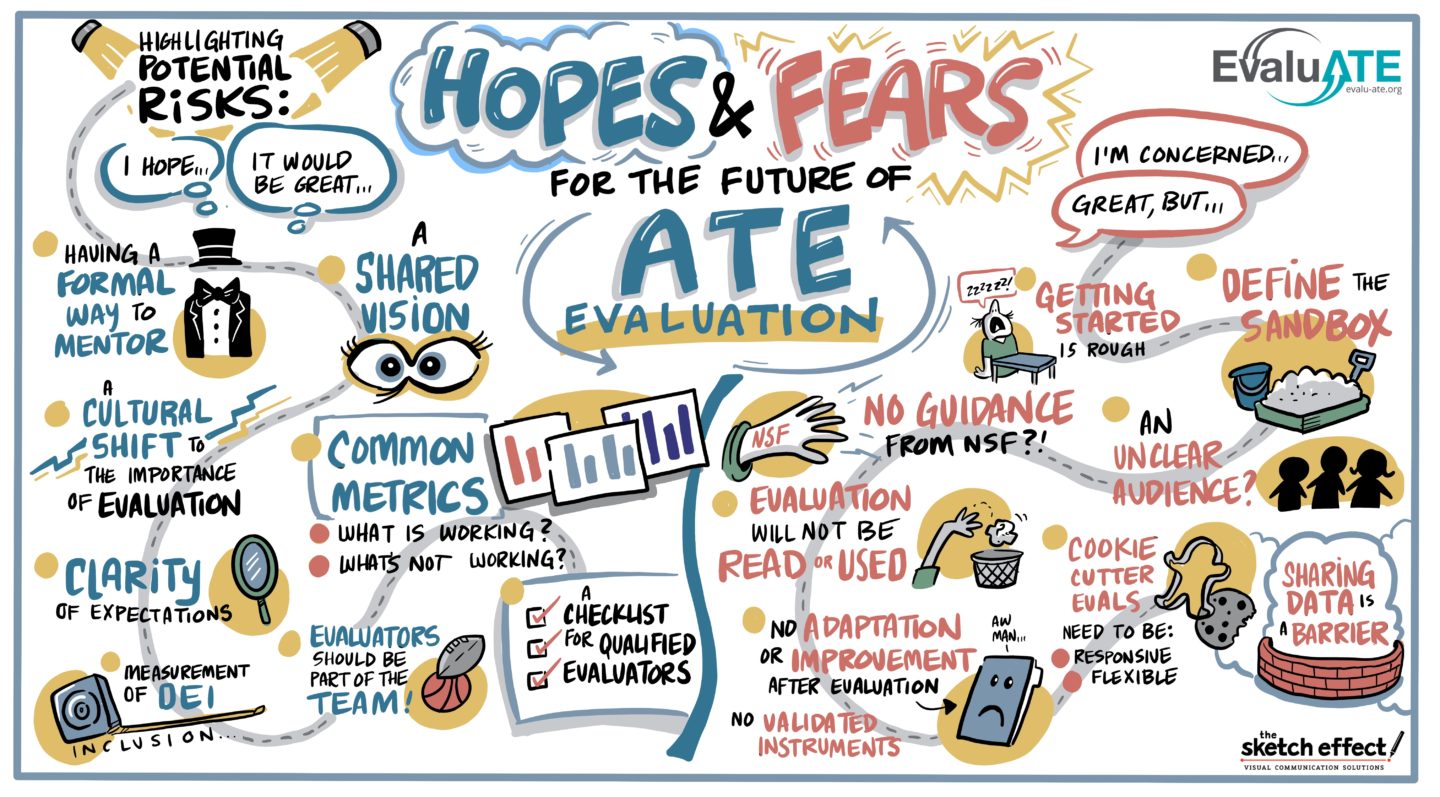What were the goals of the summit?
The ATE Evaluation Summit aimed to bring together ATE project staff, evaluators, NSF program officers, and EvaluATE to discuss the current and future state of ATE evaluation.
Through discussions, we aimed to contribute to the improvement of ATE evaluation by:
- Collectively identifying what high-quality ATE evaluation looks like in practice,
- Identifying barriers and facilitators in ATE evaluation, and
- Strengthening relationships between ATE project staff, evaluators, and NSF program officers.
Graphic recordings from the 2023 ATE Evaluation Summit
A graphic artist from The Sketch Effect joined our event. He listened throughout our small and large group discussions to bring our conversation to life in a visually compelling and memorable way. You can view the discussion topics and their visual representations below.
Reflection on The State of Evaluation in the ATE Program report
Identified meaningful trends and interpretations from current practices in ATE evaluation. Built a shared foundation for future conversations.
- How did the findings in the report reflect your experience with evaluation in the ATE program?
- How did the findings in the report not reflect your experience with evaluation in the ATE program?
- What is one finding that stood out to you in the report? Why?


ATE Evaluation Hopes and Fears
Working to understand the expectations and hesitations around ATE evaluations from various perspectives and gaining a shared understanding of ATE evaluation.
- What are your hopes for evaluation in the ATE program? What do you hope it accomplishes?
- What are your fears for ATE evaluation? What makes you hesitant or cautious about evaluation in the ATE program?
How do the JCSEE program evaluation standards show up in ATE evaluation?
Identifying what high-quality evaluation should look like in the ATE context using the standards.


What would bad ATE evaluation look like?
Thinking of the worst ideas possible can help us reverse to find solutions.
- What would bad ATE evaluation look like?
- How might we facilitate bad ATE evaluation?
Mapping the systems surrounding ATE evaluation
To understand connections, drivers, and patterns around ATE evaluation, we worked to identify the facilitators and barriers to closing the gap between the current state of ATE evaluation and future aspirations.
- Reflecting on a cluster mapping activity that was conducted, what patterns emerged? Was anything surprising?
- What are some facilitators to good ATE evaluation?
- What are some barriers to good ATE evaluation?


Start, Stop, Continue
To get balanced, actionable feedback, groups were encouraged to optimize and improve a situation with clear actions.
- To achieve the aspirations we have discussed for high-quality evaluation, what needs to start, stop, and continue?

Who participated in the summit?
ATE Evaluators
Kathleen Dean
Mike FitzGerald
Dave Hata
Candiya Mann
Silvana McCormick
Kavita Mittapalli
Lana Rucks
Sonja Schmitz
Julia Siwierka
Nikki Stoicoiu
Jeff Sun
Ingrid Vargas
NSF Program Officers
Mary Crowe
Chris Delhanty
Connie Della-Piana
Kalyn Owens
ATE PIs and Project Staff
Elizabeth Azhikannickal
Kendra Bouda
Joshua Castleberry
Mary Hojnacki
Faye Jones
Grayson McKeown
Edna Noga
Pam Silvers
Esperanza Zenon
EvaluATE
Maureen Green
Arlen Gullickson
Samantha Hooker
Megan Lopez
Valerie Marshall
Kelly Robertson
Erika Sturgis
Lyssa Wilson Becho
Lori Wingate

 EvaluATE is supported by the National Science Foundation under grant number 2332143. Any opinions, findings, and conclusions or recommendations expressed on this site are those of the authors and do not necessarily reflect the views of the National Science Foundation.
EvaluATE is supported by the National Science Foundation under grant number 2332143. Any opinions, findings, and conclusions or recommendations expressed on this site are those of the authors and do not necessarily reflect the views of the National Science Foundation.